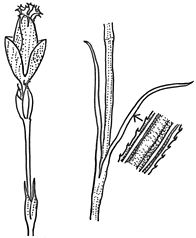Petrorhagia nanteuilii (Burnat) P.W.Ball & Heywood APNI* 
Description: Erect annual herb to 60 cm high; internodes terete or somewhat furrowed, either covered in simple hairs or glabrous.
Leaves 1–7 cm long, c. 2 mm wide; sheaths slightly longer than broad.
Involucral bracts without keels, apex obtuse; inner bracts to 18 mm long. Flowers subsessile. Calyx 10–14 mm long.
Capsule c. 6 mm long; seeds 1.3–1.6 mm long, tuberculate.
Flowering: Flowers September–December
Distribution and occurrence: Widespread but scattered weed in all regions of the State except the far NW and NE. Native of Eur. A weed of pastures and disturbed ground.
NSW subdivisions: *CC, *SC, *NT, *CT, *ST, *NWS, *CWS, *SWS, *NWP, *SWP, *SFWP
Other Australian states: *Qld *Vic. *Tas. *W.A. *S.A.
The shortly tuberculate seeds are one of the easiest features to distinguish this from P. dubia, which has strongly glandular-papillate seeds. This is an allotetraploid, possibly having P. dubia and P. prolifera (L.) P. Ball & Heyw. as its diploid parents. Hybrids between P. nanteuilii and P. dubia have been recorded for SC, NT, CT, CWS, Tas.
Text by A. Doust (1990); edited KL Wilson (May 2010, Jan 2016)
Taxon concept: Flora of NSW 1 (1990)
APNI* Provides a link to the Australian Plant Name Index (hosted by the Australian National Botanic Gardens) for comprehensive bibliographic data
***The AVH map option provides a detailed interactive Australia wide distribution map drawn from collections held by all major Australian herbaria participating in the Australian Virtual Herbarium project.
|


